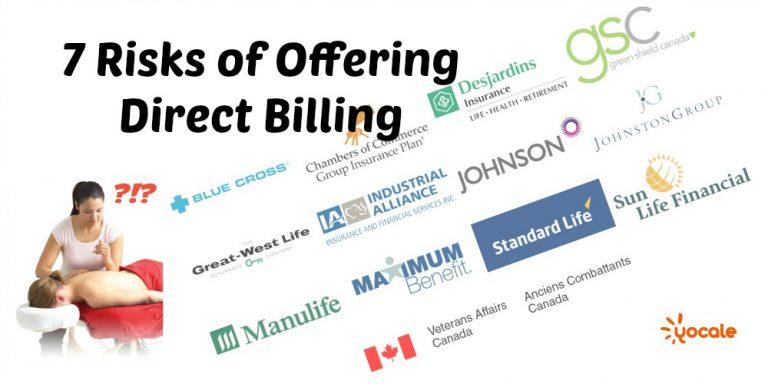Many health care professionals are faced with pressure to offer clients direct billing to insurance. This means that their clients don’t need to pay up front for services but rather, by providing their insurance details; the provider submits the claim and gets paid directly from the insurance provider. Although this is a nice marketing feature and many clients seek it out so they don’t have to pull any cash out of their own pockets for the service, it does add a lot of risk to the provider. Here are some things service providers should consider before blindly jumping into offering direct billing for all their clients because they think they need to be competitive in business. [bctt tweet=”There are many risks service providers should consider before blindly jumping into offering direct billing for their clients.”]
- When you offer direct billing, you now take responsibility for the funds from the insurance company and are liable if there are any problems with the claim.
- Client claims can be denied and you won’t know immediately when you put the claim through electronically. Many providers feel uncomfortable notifying the client about this after the fact, so then just take the loss and now have an unpaid service. The insurance companies don’t have to ask the the customer for payment because of coverage issue is now the responsibility of the healthcare providers.
- Providers who submit claims are liable to be audited for any claims submitted. If a client submits their own receipts themselves, they are liable for any insurance discrepancies and will be contacted directly.
- Insurance companies can take up to 30 days to pay providers, that leaves the provider carrying the expenses of the business and practice for a service already rendered. In a busy, multi-practitioner business, when staff needs to be paid, this can add a lot of extra headache and expense to manage this lag in cash flow.
- It can be an administration headache: Providers need to understand all the different billing company’s ever changing claim policies and keep up to date with changing requirements. Offering this service for your clients at no extra fee can mean a lot of extra hours of stressful administration that isn’t adding anything to your bottom line.
- It’s really easy for your clients to submit their own insurance receipts. Train your clients how to do it themselves and then you don’t have to take on the added stress. If you create a space right in your office or on your website that shows your clients how easy it is to submit the receipt seed and get payment they will do it themselves.
- Protect yourself from fraud. Just be aware that when you give clients receipts with your registration number on it for them to submit their own claims, people could use your number fraudulently, you may be contacted by insurance companies to confirm service dates, but that’s a lot easier than dealing with an insurance audit*.
These are all things to consider before succumbing to the pressure of offering direct billing to your clients. Yes, some clients may not have the cash to pay for their services but remind them that if they put their purchase on a credit card, they have 30 days to pay that bill and if they submit their receipt right away (online is best) they will have received their reimbursement before the bill is due. As consumers, we are used of paying for products and services right as we receive them, asking for your clients to pay up front for their services will not deter them from choosing you – and it protects you from dealing with a lot more risk.
You can also use practice management software, such as medspa practice management software to easily manage the payments and reduce your payment processing fees.
*Here’s the story of a recent client of mine, an RMT with over 10 years of practice experience who went through an insurance audit of 22 of her clients. There was no specific reason for the audit but she was required to send every treatment record for 2 years and some of these clients were weekly/bi-weekly clients. That’s a lot of paperwork! She hadn’t used electronic notes, so at the time she had to fax her hundreds of sheets in to the insurance company and they reviewed ever well-written, long form plans. This process took her a good 25-30 extra hours of her time, finding and double-checking everything and then when she received her report, due to some shorter treatment plans, and minor spelling & date mistakes – she was given a BILL for $1800 for treatments the insurance company decided not to pay! These were all treatments she had done, there was no evidence of fraud but it was their “decision” to find her liable for the treatments, and not her clients.




